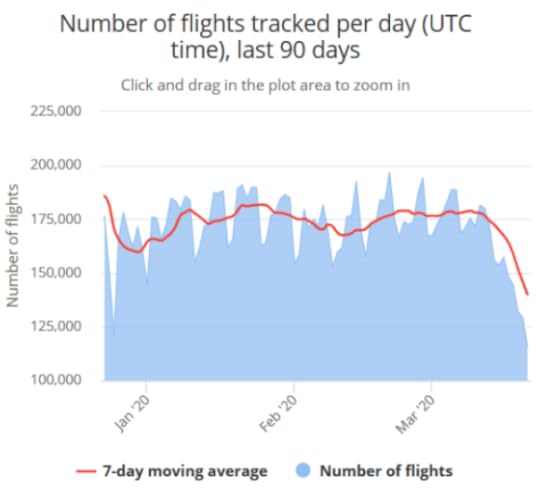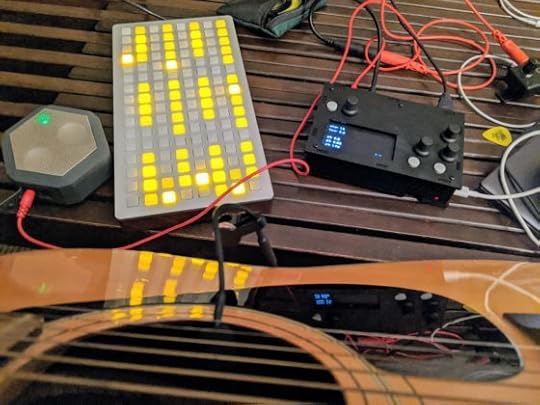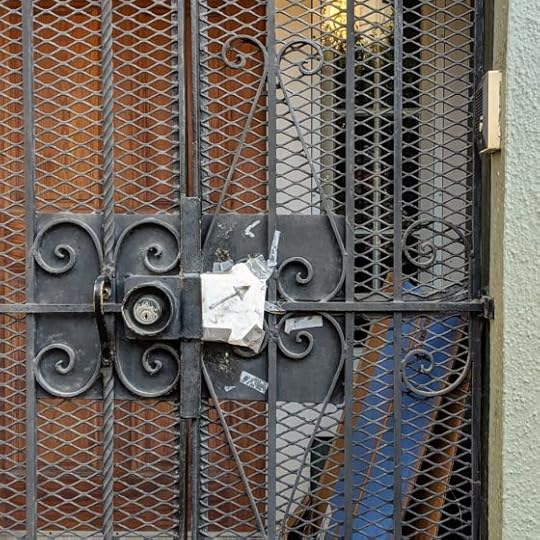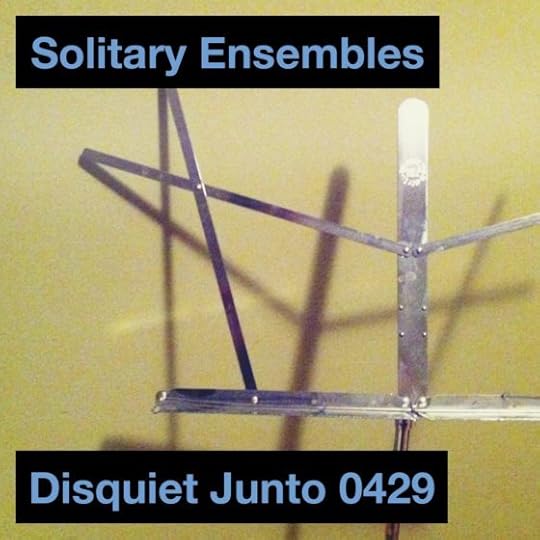Marc Weidenbaum's Blog, page 245
March 23, 2020
A Cello Transformed, and Transformed Again
“Flacholet” is described by its composer-performer, Henrik Meierkord, who is based in Stockholm, Sweden, as “An organism of cello.” That is apt. The track is as if the cello has taken on a life of its own, a life enabled by some sort of electronic assistance. The slow sawing of the strings is rendered with depth and warmth, and the droning that it yields becomes as much a part of the composition as the originating tones. Halos of sound appear, and textured moments yield brief, sharply defined cameos before fading into the lush lull.
And as it turns out, the track itself has taken on a life of its own, as well. It was picked by by Marco Lucchi, of Modena, Italy, with Meierkord’s consent, and pushed even further into atmospheric realms. “Separasjon” builds on the drone-like qualities of the original, reducing the highs and lows of the drama in favor of something hushed but no less powerful.
“Flacholet” originally posted at soundcloud.com/enrikeierkord. More from Henrik Meierkord at henrikmeierkord.bandcamp.com and soundbread.se. “Separasjon” originally posted at soundcloud.com/marcolucchi. More from Marco Lucchi at marcolucchi.bandcamp.com. (Meierkord was the cellist featured in the score to the 2018 Oscar-nominated stop-motion animation Negative Space.)
Guitar Through Gates
View this post on InstagramA post shared by Marc Weidenbaum (@dsqt) on Mar 23, 2020 at 9:25pm PDT
A little after-dinner experimentation, making some headway amid our collective new abnormal. When I post things here I myself recorded, I tag them studio journal. Acoustic guitar through randomized sequences of gates. Took awhile to sort a good BPM to align with the strumming: too fast and the chord ended too late; too slow and the gating ended before the chord fully rang out. This is a little first-time experiment with the new Torii script (version 0.3.0) by Steven Noreyko, running on a Fates (aka an open-source Monome Norns port). A Zoom H4n served as the microphone, and that’s a little Boombotix REX speaker in the foreground.
User Feedback

There is an understanding in user-interface work that an individual who clicks on something might further register the action if they experience some manner of feedback resulting from their action. There is also an understanding in user-interface work that succinct messages work best. These two understandings collide at the entrance to this apartment building.
I tried something different this time when I posted the photo. I put it up on Instagram, Facebook, and Twitter and asked people to provide their own captions. A bunch of folks piped up, and I liked these two responses in particular: jdginstagramz (via Instagram): “Self-Captioned.” And Paul Lamere (via Twitter): “TCP doorbell.”
March 22, 2020
When Clear Skies Aren’t Blue Sky

It’s been quiet — understandably so, given the circumstances — in the Richmond District of San Francisco, where I live. I’ve mentioned characteristics of the quiet previously, and wondered about the quiet not just on the ground but in the air. Above is an image of what San Francisco’s airspace looked like this morning as I drank coffee. Below is a chart of the decline in flights globally (as tracked by Flightradar24.com, also the source of the map).

In his book One Square Inch of Silence: One Man’s Quest to Preserve Quiet, Gordon Hempton takes the concept of a place on Earth where the sound of a plane does not intrude as a means by which to measure environmental health. He considers not just everyday air traffic like freight and commercial routes, but the unique tension where the planes are a self-contradictory byproduct of nature tourism, such as in the National Parks here in the United States:

And very much to Hempton’s point, the presence of silence has correlated directly with a slowdown of our planet’s machines, flying and otherwise, in reaction to COVID-19. This widely distributed NASA/ESA graphic comparing air quality in Wuhan, China, a year ago and today is clear evidence. (More at cbs.ca.) Here in the Bay Area, air pollution has already reportedly dropped by 38% (sfgate.com).

However, the thing our current quiet has reaffirmed for me, as an admiring if pragmatic reader of Hempton’s book (also recommended: the associated documentary, Soundtracker), is that silence is contextual. I’d go so far as to say that silence is synonymous with context; it is the sense, the setting, the environment (using the broader sense of the term) in which life unfolds. An argument attributing restorative qualities to our current quiet would be tough to make. This is a very different quiet, not a presence but a void.
On the Other Side
March 21, 2020
After Leaving

After today’s Leaving Records event, I needed some late-night guitar/Norns/Grid time.
(Fates, not Norns, but you know.)
The Extended Gap

Walking at night to the ocean and back feels ominous. There may be no need for another, more specialized or nuanced word. Virtually everything in the city that isn’t shut down shuts down early these days, so there is little reason to go out at night, except to walk to the ocean and back. Very few cars come and go because there are very few places to come to and go from. It’s quiet in a deeply unfamiliar way, the widespread societal inactivity all the more so. Few if any planes fly overhead. You can walk a quarter mile and not see another human. It’s dream-quiet, movie-set quiet. Until it isn’t. A simple sound carries further than usual. The thud of dinner being delivered outside someone’s front gate a block away registers hard. The extended gap in time between the thud and the sound of the gate finally being opened does, too.
Walking during the day is its own kind of ominous. People move about with their respectful distances fairly well sorted; we’re flour put through a sifter, all evenly distributed. The placidity of that metaphor belies the underlying tension. You see someone you know, and you each nod at a block’s distance, and the nods contain a mutual acknowledgment: we’ll both keep going; chatting at the distance of six feet holds little appeal at the moment. You pause in front of one of the neighborhood’s countless locked gates. The six cavities where once there were doorbell buttons are, of course, mere coincidence. But when socializing in close proximity has become so unwelcome, the gate’s blank face feels like another sort of distancing nod.
March 20, 2020
The Way Temporary Fixes Become Permanent

It isn’t about the arrow, though of course it’s about the arrow. The arrow is what catches your eye, gets you to pause, to ponder, to elect to take a photo in the first place. It also isn’t about that shallow, yellowed old doorbell mounted perpendicular to the right of the gate, though that doorbell is certainly what the arrow is about.
No, it’s about the tape, all that excess tape around the arrow. If the arrow tells us to look up and to the right to locate the doorbell, which it does, then the tape is more of a wink. The tape tells us that this arrow isn’t the first attempt by a resident of this home to direct the visitor’s eye, and index finger, in the desired direction.
If the arrow is intended to divert the eye, the tape draws the eye in toward the collage-like mass, to the assemblage of paper that’s molded around what must, at some point, itself have housed a doorbell, and to the haphazard duct tape that strives to keep the paper in place, and to the tape fragments themselves, which hint at prior signage efforts, and then further out along the surface to the mangled gate front that summons up thoughts of other forms of wear, that potent combination of environment and neglect.
As with so many after-market jury-rigged corrections to suboptimal doorbell fixes, this one is a treatise on numerous topics, all at once. There’s the failure of the original device, the problematic placement of the replacement, the covering up of the discarded ringer, the need to bridge the gap from old to new, the way temporary fixes become permanent ones. And hidden in the background, there is the source of so much of the visual confusion: the gate, of course, which further separated visitors from the front door sometime after the house’s original construction. Which is to say, the arrow was fated. Once the gate was introduced, the home owner (or landlord, or property management firm) had already effectively pointed an arrow in another direction.
After Live: Leaving Records Roster Party

Another day in global mutual self-isolation, another advance notice of a stellar virtual concert. Leaving Records announced that the following will be playing live tomorrow, Saturday, March 21, starting at 1pm Pacific Time. The time zone’s appellation also fits the tranquil electronic music of the performers: Kaitlyn Aurelia Smith, Emily A. Sprague, Brin, Cool Maritime, and Matthewdavid’s Mindflight. Set your calendar to pull up twitch.tv/leavingrecords at the appointed time. You may want to set up an account early, if you don’t have one already. This show begins four hours after Scanner’s announced show that day.
March 19, 2020
Disquiet Junto Project 0429: Solitary Ensembles
We’ve done projects along the lines of this one in the past, and it’s always worked out well, with surprising and wonderful results, new connections made, new partnerships forged, unexpected pairings created.
Current circumstances around the world bring new meaning to the project. The idea this week is that you will record the first third of what will eventually become a trio. Next week people will add to tracks from this week, and the week after people will, in effect, complete the trios. Some of this week’s projects will, inevitably, be used more than once, leading to interrelated branches of creativity — and more importantly, connecting musicians around the world.
It’s a foundational concept of the Disquiet Junto, since January 2012, that the participants all gain energy and inspiration from the knowledge that somewhere around the world, other people are cogitating on and acting on the same four-day project as they are. Projects such as this particular one build on that idea by bringing together various subsets of the far-flung Junto community into short-lived, ad-hoc, self-guided groupings — what we’re currently calling Solitary Ensembles.
The difference this time, of course, is there exists a larger set of factors we all have in common at the moment, and we have them in common not just with the 1,500 or so other subscribers to the Junto mailing list, but with the world’s populace. We aren’t just facing this creative challenge together. We are facing a new challenge in the form of the global pandemic and its ramifications — physical, emotional, economic. Which is to say: thanks, as always, for your generosity with your time and creativity, and all the more so during these strange times in which we find ourselves.
Oh, and one procedural note: It’s a rule in the Junto that musicians should only contribute one track per project. That remains the case this week. However, next week, in order for as many of this week’s tracks as possible being re-worked, that number will be increased. At the moment, I’m not certain by how much. I’ll sort that out and mention it next week.

Each Thursday in the Disquiet Junto group, a new compositional challenge is set before the group’s members, who then have just over four days to upload a track in response to the assignment. Membership in the Junto is open: just join and participate. (A SoundCloud account is helpful but not required.) There’s no pressure to do every project. It’s weekly so that you know it’s there, every Thursday through Monday, when you have the time.
Deadline: This project’s deadline is Monday, March 23, 2020, at 11:59pm (that is, just before midnight) wherever you are. It was posted on Thursday, March 19, 2020.
Tracks will be added to the playlist for the duration of the project.
These are the instructions that went out to the group’s email list (at tinyletter.com/disquiet-junto):
Disquiet Junto Project 0429: Solitary Ensembles
The Assignment: Record the first third of a trio that others will complete.
Step 1: This week’s Junto project is the first in a sequence intended to invite, encourage, and reward collaboration. You will be recording something with the understanding that it will remain unfinished for the time being.
Step 2: The plan is for you to record a short and original piece of music, on any instrumentation of your choice. Conceive it as something that leaves room for something else — other instruments, other people — to join in.
Step 3: Record a short piece of music, roughly two to three minutes in length, as described in Step 2. When done, if possible, pan the audio so that your piece is solely in the left side of the stereo spectrum.
Step 4: Also, and this is important, be sure, when done, to make your track downloadable, because it will be used by someone else in the next Disquiet Junto project.
Seven More Important Steps When Your Track Is Done:
Step 1: Include “disquiet0429” (no spaces or quotation marks) in the name of your track.
Step 2: If your audio-hosting platform allows for tags, be sure to also include the project tag “disquiet0429” (no spaces or quotation marks). If you’re posting on SoundCloud in particular, this is essential to subsequent location of tracks for the creation of a project playlist.
Step 3: Upload your track. It is helpful but not essential that you use SoundCloud to host your track.
Step 4: Post your track in the following discussion thread at llllllll.co:
https://llllllll.co/t/disquiet-junto-project-0429-solitary-ensembles/
Step 5: Annotate your track with a brief explanation of your approach and process.
Step 6: If posting on social media, please consider using the hashtag #disquietjunto so fellow participants are more likely to locate your communication.
Step 7: Then listen to and comment on tracks uploaded by your fellow Disquiet Junto participants.
Additional Details:
Deadline: This project’s deadline is Monday, March 23, 2020, at 11:59pm (that is, just before midnight) wherever you are. It was posted on Thursday, March 19, 2020.
Length: The length is up to you. Shorter is often better. Two to three minutes is probably about right for this project.
Title/Tag: When posting your track, please include “disquiet0429” in the title of the track, and where applicable (on SoundCloud, for example) as a tag.
Upload: When participating in this project, post one finished track with the project tag, and be sure to include a description of your process in planning, composing, and recording it. This description is an essential element of the communicative process inherent in the Disquiet Junto. Photos, video, and lists of equipment are always appreciated.
Download: Given the nature of this particular project sequence, it is best to set your track as downloadable and allowing for attributed remixing (i.e., a Creative Commons license permitting non-commercial sharing with attribution, allowing for derivatives).
For context, when posting the track online, please be sure to include this following information:
More on this 429th weekly Disquiet Junto project — The Assignment: Record the first third of a trio that others will complete — at:
More on the Disquiet Junto at:
Subscribe to project announcements here:
http://tinyletter.com/disquiet-junto/
Project discussion takes place on llllllll.co:
https://llllllll.co/t/disquiet-junto-project-0429-solitary-ensembles/
There’s also a Disquiet Junto Slack. Send your email address to twitter.com/disquiet for Slack inclusion.
Image associated with this track is by Abby, used thanks to a Creative Commons license and Flickr:




